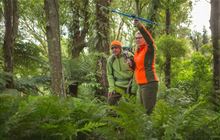Freshwater fish inventory and monitoring
Introduction
This module describes methods to inventory and monitor freshwater fish species and fish communities.How to use this module
- Read project planning guides.
- Read the methods to inventory and monitor freshwater fish.
- Consult the introduction and the comparative tables and decision trees to help you select the method(s) most appropriate for your study.
- Be aware of the minimum data collection standards for methods.
- Check if any training is available for this method.
Introduction
How to decide the best method for freshwater fish monitoring (PDF, 613K)
Read this introduction and consult the comparative tables and decision trees to help you decide the method(s) best suited for your project objectives.
Methods
Spotlighting
Spotlighting for freshwater fish: fixed reach (PDF, 564K)
This method uses observers to spotlight a standard length of stream (100–400 m) with a single pass looking for nocturnally active fish species.
Spotlighting for freshwater fish: multi pass (PDF, 564K)
This method uses observers to spotlight streams using multiple passes looking for nocturnally active freshwater fish. It is most effective for the kōkopu species.
Spotlighting by spotfishing for freshwater fish (PDF, 471K)
This method is a rapid survey method for surveying areas of a stream of particular interest. It is a low effort fishing method designed to target small areas of interest for nocturnally-active fish such as kōkopu species and can complement spot electrofishing of riffle areas.
Electrofishing
Electrofishing for freshwater fish: fixed reach (PDF, 1.085K)
This method assesses the community composition of wadeable freshwater streams to estimate taxa richness and relative abundances using a backpack electrofishing machine. Other measures of population structure (e.g. size/age class representation) can also be obtained if adequate numbers of fish are collected.
Electrofishing for freshwater fish: multi-pass (PDF, 653K)
This method assesses the abundance or density of freshwater fish within a site using a backpack electrofishing machine.
Electofishing by spotfishing for freshwater fish (PDF, 608K)
This method describes a suite of approaches to monitor the presence/absence and distribution of fish species and to collect freshwater fish samples from habitats using a backpack electrofishing machine.
Passive nets
Passive nets for freshwater fish: fyke nets (PDF, 756K)
This method describes how to use fyke nets to sample freshwater fish in a wide range of environments including lakes, wetlands, rivers and streams.
Passive nets for freshwater fish: minnow traps (PDF, 916K)
This method describes how to use minnow traps to sample freshwater fish in a wide range of environments including lakes, wetlands, rivers and streams.
Passive nets for freshwater fish: gill nets (PDF, 694K)
This method describes how to use gill nets to intercept, capture and hold freshwater fish to monitor the presence/absence or to estimate taxa richness of fish species. They have bias towards certain fish species and fish sizes.
Other documents
New Zealand mudfish
A revised methodology to survey and monitor New Zealand mudfish species (PDF, 1,192K)
This document describes how to monitor New Zealand mudfish species and was originally published as the stand alone report (Ling, N., O’Brien, L.K., Miller, R., Lake, M. 2009. Methodology to survey and monitor New Zealand mudfish species. CBER Contract Report 104. Department of Conservation and University of Waikato, Hamilton. 60 pp). It is reproduced here with permission from the authors, with updates and modifications.


